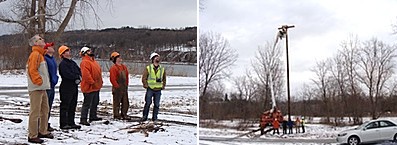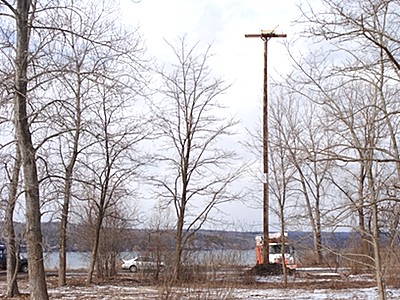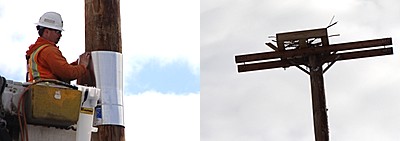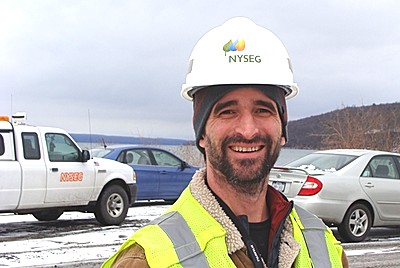- By Dan Veaner
- Around Town
 Print
Print  'New 1 bedroom single family home with outstanding Cayuga Lake view, access to hunting and fishing, perfect for a young family, ready to move in.' That could be a realty sign on Salt Point where a platform for an osprey nesting platform was installed Tuesday morning. While it is possible the 65 foot tall nest could attract eagles, NYSEG Forester Paul Paradine says attracting osprey would be a coup on the DEC owned (New York State Department of Environmental Conservation), Town of Lansing operated nature park.
'New 1 bedroom single family home with outstanding Cayuga Lake view, access to hunting and fishing, perfect for a young family, ready to move in.' That could be a realty sign on Salt Point where a platform for an osprey nesting platform was installed Tuesday morning. While it is possible the 65 foot tall nest could attract eagles, NYSEG Forester Paul Paradine says attracting osprey would be a coup on the DEC owned (New York State Department of Environmental Conservation), Town of Lansing operated nature park."We're hoping for osprey," Paradine says. "There is a pair of eagles that I am pretty sure nests near Salmon Creek. They have been there for some time and are probably the only pair in this area that dominate the location. You never know, but we're hoping for osprey because it will be unique, considering there is only one other location."
 Lansing park officials and NYSEG employees watch as an osprey nesting platform is installed on a 65 foot tall utility pole
Lansing park officials and NYSEG employees watch as an osprey nesting platform is installed on a 65 foot tall utility poleThat other nest is just down the road, also by the lake. Osprey had built a nest on top of a power line at the lakeside Cargill salt mining operation, but it was too close to the wires. During the winter some of the nesting materials drooped down the pole, touching a high voltage line and setting the utility pole on fire. When firefighters responded the nest was blown off the pole.
Paradine a Lansing resident, is a former raptor bioligist working with endangered species in California before becoming a forester here. His fiancée Robyn Bailey, a professional wildlife biologist at the Cornell Lab of Ornithology, got him involved, and NYSEG was able to save the nesting location in cooperation with Cargill.
"Fortunately the osprey were not in the nest in the winter," he says. "We were able to get it back up and reestablished before they returned to find it missing. We donated a riser that would get the nest up another six to eight feet above the pole. Everyone came together, and we got a new platform installed just in time. About two weeks after they returned, built a new nest there, and fledged two chicks."
The Town of Lansing is currently working on a project to close most of Salt Point to vehicular traffic to encourage wildlife and creating a natural area for hikers. Lansing Parks Superintendent Steve Colt says that helps fulfill the original Salt Point master plan that was developed by local and Cornell student groups. It will also isolate the nest location from motor vehicles, making it a more attractive spot for raptors.
 Penthouse with a lake view
Penthouse with a lake view"It's a great location," Paradine says. "We looked at the minimum separation distances from other nests and everything else. The DEC inspected the site and confirmed it would be a good location."
Colt wanted to mount an osprey platform on an existing utility pole on Salt Point. he approached NYSEG to make sure the power lines on the pole were not live. He was put in touch with Paradine, who was immediately excited by the project.
Experts from the Lab of Ornithology and the Cayuga Bird Club were consulted and the Cornell lab provided plans to make sure the platform is built to optimum specifications and placed in the most advantageous locaton.
That led to a search for a taller pole , more in keeping with the height osprey may be attracted to. They found a out of service 65 foot tall 'Class 1' pole, which is larger and more stable than the average utility pole. Paradine says the extra stability is needed in an area where wind is a significant factor. His crew attached cross-arms to act as bracing for the nest, and Paradine himself donated materials to build a platform, which he built with his crew, Kim Denman and Lou Condes.

It is a large platform with a wire mesh bottom. A diagonal plank spalys off to one side with a mitered trench to enhance the bird's grip when it perches there. Roof flashing was wrapped around the pole about a third of the way up to prevent other animals from climbing up to the nest and disturbing the eggs.
"They'll defend up to 500 feet from their nest, and defend their chicks up to 100 feet. There is plenty of space between this nest and the one at Cargill, so it will be a good spot for them."
NYSEG workers volunteer their time for projects like this. Two employees from the Line Department worked with Paradine to erect the nesting platform. Digging a hole that near to the lakeshore presented challenges last Friday.
"When they excavated the hole they hit water very quickly," Colt says. "They weren't sure what they were going to hit because there is so much rubble and concrete on Salt Point. So the pole is what they classify as a 'floating pole'. They brought material from the Salmon Creek dredging to fill in around it."
 Flashing on the pole will protect the nest from predators. Driftwood in the platform acts as a 'welcome mat' to help attract birds to nest there.
Flashing on the pole will protect the nest from predators. Driftwood in the platform acts as a 'welcome mat' to help attract birds to nest there.Tuesday a line crew came to install the platform, but as luck would have it the cherrypicker Paradine wanted was out for repairs. That machine would have made it easy to reach the top of the pole. A shorter machine gained a few extra feet when they parked it on a small berm next to the pole. That turned out to be just enough height.
Paradine is responsible for the NYSEG tree crews that trim branches to clear the way for transmission and distribution power lines. His crew clears out overgrown foliage along the paths transmission lines take around his region, which spans from Auburn to Watkins Glen, Geneva, Cortland and Auburn and includes Tompkins County. His crew tries to avoid particularly sensitive habitats or maintain them in such a way that they favor the habitat or species that live there. He says the nests can reach several hundred pounds, so he plans to come back to this and the Cargill nest every so often to trim the nest and check the platform to make sure it can continue to support that weight.
 NYSEG Forester Paul Paradine
NYSEG Forester Paul ParadineThe timing of the project is so perfect it would make a realtor weep. North American osprey spend their winters in the Gulf Coast, Florida, the Caribbean, and some in South America. They are strong fliers, expected to return to Central New York within the coming month. When they do they will find the perfect nesting spot on the lakefront with a penthouse view, the perfect height to spot potential threats and swoop down on prey.
"With the climate warming and conditions changing the birds are returning earlier and earlier in the year," Paradine says. "We wanted to beat the clock and get it up and ready to go. Hopefully we'll get some activity in two weeks to a month."
v9i11



